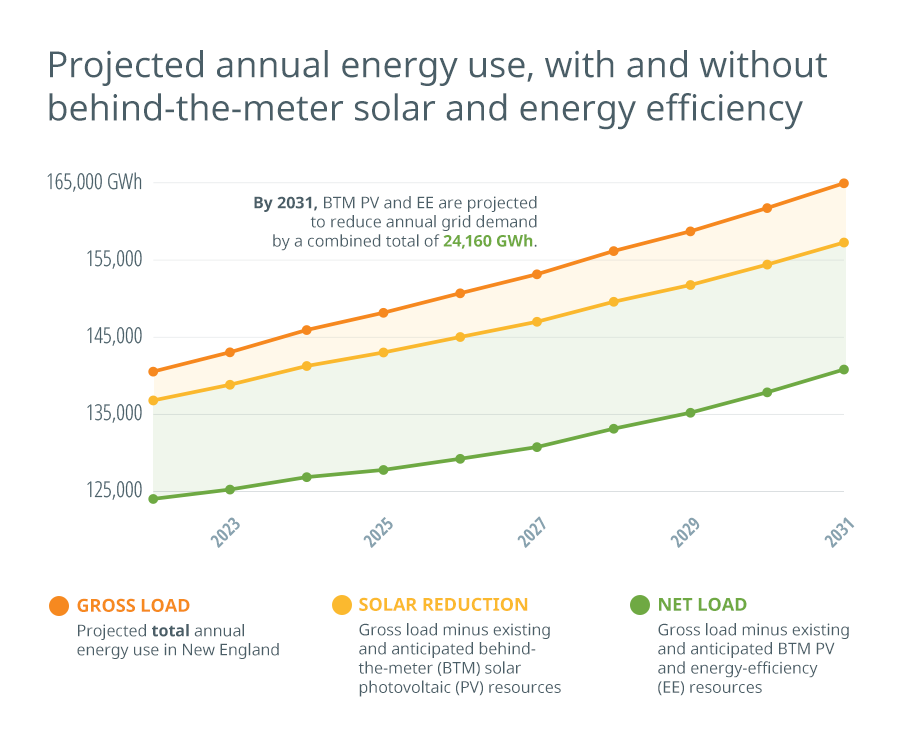Electricity use in New England expected to increase over the next decade, according to 2022 CELT report

ISO New England is projecting the region’s annual net electricity use to increase by about 14% over the next decade as the heating and transportation sectors go electric. The findings were published in the 2022-2031 Forecast Report of Capacity, Energy, Loads, and Transmission (CELT), a primary source for assumptions used in ISO system planning and reliability studies.
The CELT provides a snapshot of the New England power system, including:
- A long-term forecast for energy consumption and peak demand, including 10-year forecasts accounting for the impacts of energy efficiency (EE) and behind-the-meter (BTM) solar generation
- The number of megawatts (MW) with capacity supply obligations, as well as the total generating capability of resources in the region
- A breakdown of the region’s generators by fuel/unit classification
- A link to the listing of transmission projects proposed, planned, and under construction
New England electricity projections for 2022 to 2031
The ISO develops the gross long-term forecast for electricity demand using state and regional economic forecasts, years of weather history in New England, and forecasts for energy demand to power electric vehicles (EVs) and air-source heat pumps (ASHPs). This year’s Transportation Electrification Forecast includes school buses, transit buses, and other fleet vehicles in addition to personal light-duty EVs.
Results of the ISO’s EE forecast and solar photovoltaic (PV) forecast are applied to the gross forecast to develop a net long-term forecast.
Overall electricity use in New England
| Total Annual Use (GWh) | 2022 | 2031 |
| Gross Forecast | 140,536 | 164,965 |
| Net Forecast | 124,019 | 140,805 |
- Gross annual electricity use is expected to grow by 1.8% annually over the 10-year period, while net annual use is expected to grow by 1.4% annually.
- EE is projected to reduce grid demand by 12,771 gigawatt-hours (GWh) this year and 16,468 GWh in 2031.
- BTM PV is projected to reduce grid demand by 3,747 GWh this year, rising to 7,692 GWh in 2031.
- EVs are expected to account for 5,934 GWh of grid demand in 2031, while ASHPs are expected to account for 3,056 GWh of demand that year.

Summer peak demand, average weather
Peak demand is a measure of the highest amount of electricity used in a single hour. Average weather is used to develop what is known as the 50-50 forecast, meaning there is a 50 percent chance that peak demand will be above or below the forecast.
| Peak Demand (MW) | 2022 | 2031 |
| Gross Forecast | 27,743 | 29,519 |
| Net Forecast | 24,686 | 25,322 |
- Under typical summer weather conditions, gross peak demand is expected to rise annually at a rate of 0.7%. Net peak demand is expected to rise at an annual rate of 0.3%. The same rates are forecast for weather that is hotter than average.
- The net forecast includes summer peak demand reductions from BTM PV of 903 MW this year, rising to 1,115 MW in summer 2031.
- EE is expected to reduce summer peak demand by 2,153 MW this year, and by 3,082 MW in 2031.
- Transportation electrification is expected to contribute 1,096 MW to summer peak demand in 2031.
Summer peak demand, hotter than average weather
The 90-10 forecast—which reflects above average heat and humidity in the summer, and colder than average temperatures in the winter—means there is a 10 percent chance that peak demand will be higher than the forecast.
| Peak Demand (MW) | 2022 | 2031 |
| Gross Forecast | 29,472 | 31,336 |
| Net Forecast | 26,416 | 27,139 |
Winter peak demand, average weather
| Peak Demand (MW) | Winter 2022-2023 | Winter 2031-2032 |
| Gross Forecast | 22,031 | 25,880 |
| Net Forecast | 20,009 | 22,852 |
- Under the 50-50 forecast, winter gross peak demand is expected to rise by an average of 1.8% annually through the winter of 2031-2032, while net peak demand is expected to rise by 1.5% annually. The same rates are forecast for weather that is colder than average.
- Transportation electrification is forecast to contribute 1,535 MW to the winter peak in 2031-2032.
- Heating electrification is projected to contribute 1,899 MW to the winter peak under average weather in 2031-2032.
- BTM PV does not reduce winter peak demand, because the peak typically occurs after sunset.
Winter peak demand, colder than average weather
| Peak Demand (MW) | Winter 2022-2023 | Winter 2031-2032 |
| Gross Forecast | 22,717 | 26,725 |
| Net Forecast | 20,695 | 23,696 |
Heating electrification is projected to contribute 2,032 MW to the winter peak under colder than average weather in 2031-2032.



